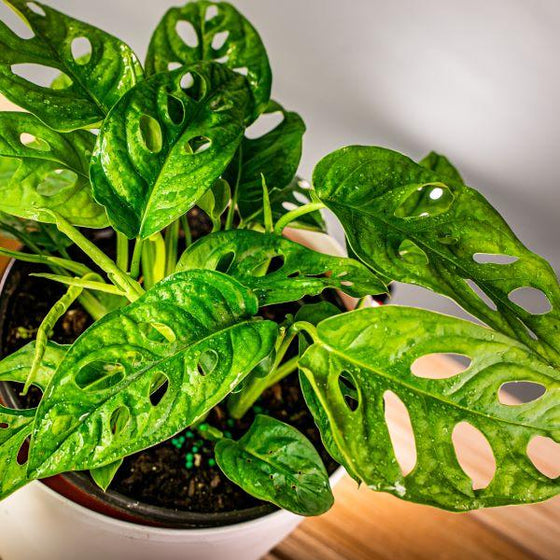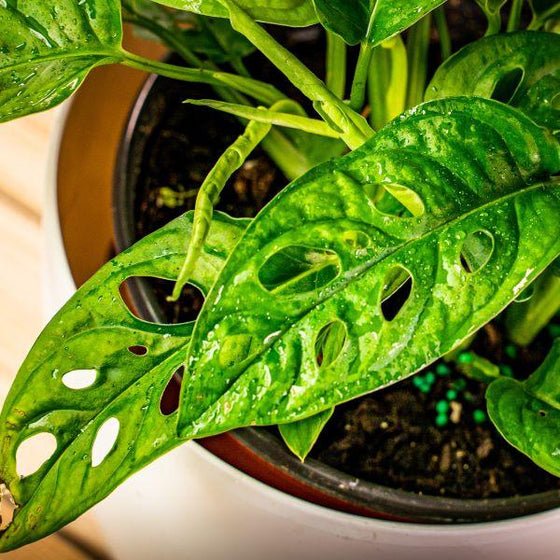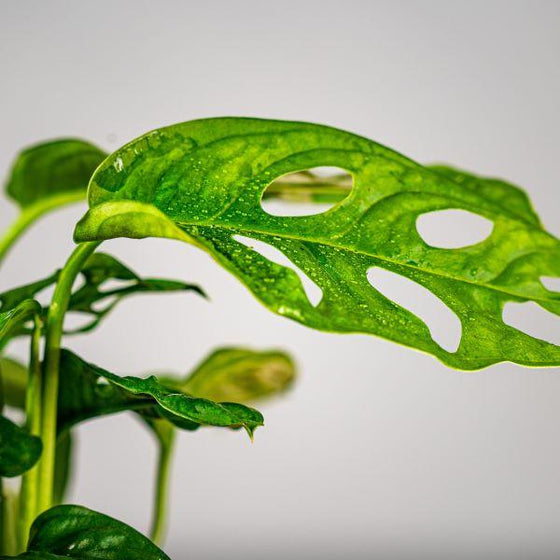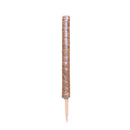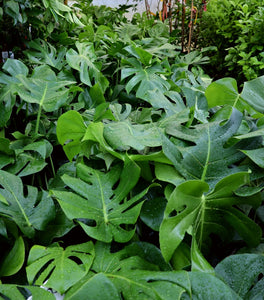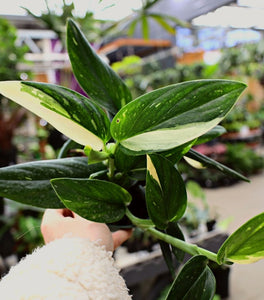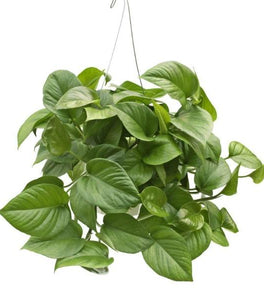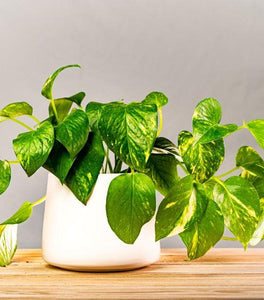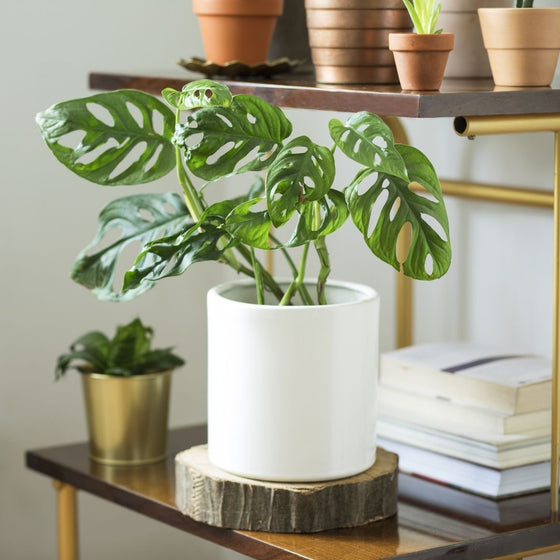
Images Depicted Range in Maturity & Container Size
Pots & Decorations Not Included Unless Otherwise Stated
Monstera adansonii for Sale Online
Monstera adansonii, also known as the Swiss Cheese Plant, is a striking indoor vine prized for its unique, fenestrated leaves. The distinctive oval-shaped holes in its lush, green foliage give it a tropical, eye-catching appearance that makes it perfect for adding visual interest to any indoor space. This fast-growing plant can be trained to climb up a trellis or left-to-trail from hanging baskets, making it versatile for a variety of decor styles. Monstera adansonii thrives in bright, indirect light and enjoys well-draining soil, making it a relatively easy plant to care for, even for beginners.
In addition to its aesthetic appeal, Monstera adansonii is a low-maintenance plant that brings a touch of the tropics indoors. With minimal watering requirements and adaptability to various light conditions, it's an excellent choice for plant enthusiasts who want a dramatic, conversation-worthy plant. Regular misting helps maintain its humidity needs, ensuring its leaves stay vibrant and healthy. Whether as a statement plant in a room or part of a larger indoor jungle, Monstera adansonii is the perfect addition for those seeking both beauty and ease in plant care.
This climbing vine is on our list of 2020's Trendiest Houseplants.
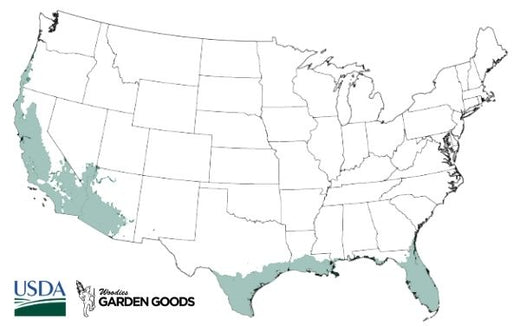
| Hardiness Zone: | 9-11 |
|---|---|
| Mature Height: | 30 to 36 Inches if supported |
| Mature Width: | 36 Inches |
| Classification: | Tropical |
| Sunlight: | Fluorescent light to bright, indirect |
| Habit: | Upright |
| Flower Color: | Does not flower often |
| Foliage: | Dark green |
| Soil Condition: | Well draining, cactus or succulent mix (part sand) |
| Water Requirements: | Likes to go dry |
| Uses: | Does well indoors and in low light conditions |
How to Care for Monstera adansonii
Before you buy a Swiss Cheese Vine Plant, make sure to read the recommended care instructions to keep this plant healthy and thriving for years to come!

What is the best light for Monstera adansonii Plants?
he best light for Monstera adansonii plants is bright, indirect light, which allows them to thrive and develop their signature fenestrated (holey) leaves. Placing the plant near a north or east-facing window where it receives filtered sunlight will encourage healthy growth without risking sunburn on the delicate foliage. Avoid direct sunlight, as it can scorch the leaves, causing them to turn yellow or brown. If you don’t have access to bright natural light, Monstera adansonii can also tolerate lower light conditions, but growth may slow, and the leaves may not develop as many holes. In low-light environments, Monstera adansonii may produce smaller leaves and fewer fenestrations, so supplementing with artificial grow lights can help maintain healthy, vibrant foliage. Ensure the plant receives about 6-8 hours of indirect light each day for optimal growth. This adaptable plant does well in most indoor spaces, making it an excellent choice for brightening up living rooms, offices, or bathrooms. By providing the right amount of indirect light, your Monstera adansonii will reward you with its distinctive, lush green leaves and vigorous growth.
How often do I water Monstera adansonii Plants?
You should water Monstera adansonii plants when the top 1-2 inches of soil feel dry to the touch, which typically means watering every 7-10 days depending on the humidity and light conditions in your home. These tropical plants prefer evenly moist soil but do not tolerate waterlogged conditions, as this can lead to root rot. It’s important to thoroughly water the plant until excess water drains out of the pot, ensuring that the roots are hydrated. Then, allow the soil to dry slightly before watering again. During the growing season in spring and summer, your Monstera adansonii may require more frequent watering due to increased water needs. In the fall and winter months, Monstera adansonii enters a period of slower growth, so you’ll need to reduce the frequency of watering. Always check the soil moisture before watering to prevent overwatering, which is a common mistake with indoor plants. If your home is dry, especially in the winter, consider misting the plant occasionally or using a humidifier to maintain the moderate humidity levels Monstera adansonii prefers. Following a consistent watering routine will help ensure your plant remains healthy, with vibrant, fenestrated leaves and strong growth throughout the year.
How do I fertilize Monstera adansonii?
To fertilize Monstera adansonii, use a balanced, water-soluble fertilizer with a ratio like 20-20-20 or 10-10-10 during the growing season, which spans spring and summer. Dilute the fertilizer to half-strength and apply it once a month to provide essential nutrients like nitrogen, phosphorus, and potassium that support healthy leaf growth and strong root development. Be sure to water the plant before applying the fertilizer to prevent root burn. This regular feeding will help your Monstera adansonii produce larger, more vibrant leaves with the signature fenestrations that make it so distinctive. During the fall and winter months, when Monstera adansonii enters a slower growth phase, reduce fertilizing to once every two to three months or stop entirely. Over-fertilizing during this time can lead to salt buildup in the soil, which may damage the roots. Organic fertilizers, like compost tea or liquid seaweed, can also be used for a gentler feeding option. Always monitor your plant for signs of nutrient deficiencies, such as yellowing leaves or slow growth, and adjust your fertilizing schedule accordingly. Proper fertilization will keep your Monstera adansonii thriving with lush, healthy foliage all year round.

What is the best soil for Monstera adansonii Plants?
The best soil for Monstera adansonii plants is a well-draining, rich potting mix that retains some moisture but doesn’t become waterlogged. A high-quality aroid mix or a combination of all-purpose potting soil mixed with perlite and orchid bark works perfectly, as these ingredients improve drainage and aeration while providing the right level of moisture retention. This type of soil helps mimic the plant's natural tropical environment, ensuring that the roots get enough air and moisture without being suffocated by excess water. Additionally, using soil with organic matter like peat moss or coconut coir can help maintain the right moisture balance while also supporting healthy root growth. In terms of pH, Monstera adansonii prefers slightly acidic to neutral soil, with a pH range between 5.5 and 7.0. Repotting your plant every 1-2 years with fresh soil is important to keep the plant thriving, as it refreshes the nutrient content and ensures continued good drainage. Avoid using heavy, compacted soils, as these can retain too much water and lead to root rot. With the right soil mix, your Monstera adansonii will develop strong roots and grow vigorously, producing its iconic fenestrated leaves with ease.

